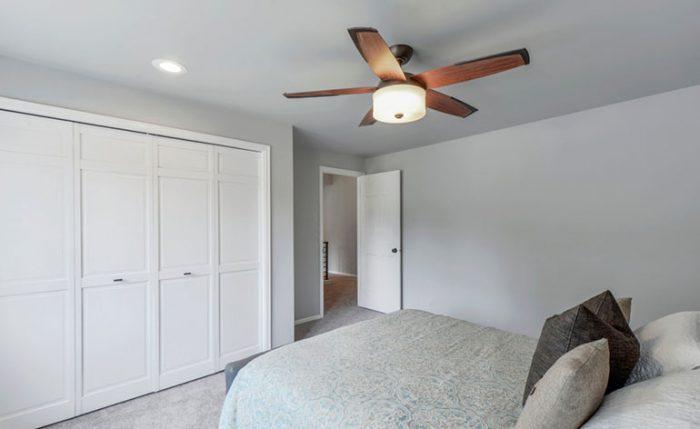Designed for indoor areas that aren’t exposed to moisture, dry-rated options can be placed in bedrooms, dining rooms, foyers, finished basements, workshops, dens, and kitchens with proper ventilation. However, they shouldn’t be installed in bathrooms, as a shower or bath will cause moisture to accumulate.
Since dry-rated fans aren’t exposed to moisture and don’t need waterproof materials, they feature a larger variety of electronic components, designs, and hues.
You are watching: The Key Differences Between Indoor and Outdoor Fans
Keep in mind that because dry-rated options are installed indoors, dust will build up over time, which can exacerbate allergies. Avoid this issue by washing each blade regularly using a cloth and cleaning agent.Additionally, the ornamentation, hardware, and lighting components tend to be more intricate. There are also more material options, such as high-grade furniture wood, balsa wood, metal, plastic, and medium-density fiberboard (MDF).
What Happens if You Use Dry-Rated Fans Outdoors?
Indoor fans aren’t built to withstand the elements, and even a little water can damage the motor, causing the fan to break down. Even worse, it can create a short and cause an electrical fire.
Additionally, the blades may melt, warp, or become uneven as a result of the outdoor heat, leading to reduced airflow, wobbling, or extra noise. Finally, the finish will rust and fade, resulting in a lackluster fan.
Damp-Rated Ceiling Fans

These are designed to function in indoor or outdoor areas where moisture builds up. However, they’re not meant to come into direct contact with water. Many homeowners place them in bathrooms, laundry rooms, screened-in porches, uninsulated garages, unfinished basements, carports, or covered patios.
Read more : BBQ4Dummies
In addition to withstanding indirect moisture, they stand up to humidity, making them ideal for humid climates or rooms with poor ventilation.
The specially designed motor housing protects the wiring against damage due to moisture, preventing fires, rusting, and unexpected breakdowns. However, the casing can’t withstand snow or heavy rain, unlike wet-rated options.
Still, many homeowners prefer damp-rated fans because they’re available in more designs and materials, including all-weather plastic, steel, and wood that’s sealed against moisture. Plus, the blades are less likely to sag over time as long as the fixture is placed in a sheltered space, such as a covered patio.
Wet-Rated Ceiling Fans
Designed to withstand contact with snow, rain, and water, wet-rated fans are highly durable. However, they generally come in fewer styles and designs than damp-rated or dry-rated options.
Homeowners often install wet-rated fans under lanais, verandas, cabanas, gazebos, exposed decks or porches, pergolas, boat docks, waterfront porches, tiki bars, or outdoor bars. They transform these outdoor spaces into ones that can be enjoyed for long hours at any time of day, as they cut down on solar heat and keep the air moving on hot, muggy nights. You can even install outdoor ceiling fans with lights to improve visibility and enhance the atmosphere.
Because moisture won’t warp, corrode, or otherwise damage the blades, these waterproof ceiling fans can be easily washed using a garden hose.
Additionally, the electrical wiring and motors are encased in waterproof and weatherproof protection, including a silicone protectant. The area above the fan is also sealed and weatherproofed to protect against leaks.
Read more : Outdoor Activities for 1 Year Olds
Wet-rated fan blades are often made from acrylonitrile butadiene styrene (ABS) plastic polymer. This lightweight material is durable enough to withstand wind, sun, and water over time, protecting the color and texture and preventing cracking and sagging.
ABS is used to manufacture components in a wide variety of products, from luggage and small appliances to the heads of non-wooden golf clubs and drain-waste-vent pipes. The material can be shaped and cut into thin strips, making it a versatile substance that can be formed into different shapes and styles of ceiling fans for outdoor spaces. Finally, ABS can be creatively manufactured to look like real wood, allowing you to have an indoor feel outdoors.
Ceiling Fans for Salt Air
Most damp- or wet-rated outdoor fans are not specifically designed to handle the corrosive effects of salt air. If you live near the ocean, consider buying stainless steel ceiling fans for both inside and outside your house. These fans are rust-resistant and weatherproof and are available in anti-corrosive painted finishes, as well as a natural brushed stainless steel. There are also a few plastic fans with ABS blades that are reasonable alternatives at lower price points.
Can You Use Outdoor Fans Indoors?

A common mistake people make when shopping for a fan for their living room or bedroom is to limit their search to indoor fans only. By doing so, they will miss out on some of the best fans. The truth is, many of the best fans on the market are specifically made as wet-rated so they can be installed anywhere.
A great example of this is the brand Modern Forms®. Not only are all their fans wet-rated, but they are also very stylish smart fans that can be controlled by voice commands, smartphones, and home automation systems. Yet, the majority of their fans are installed inside people’s homes.
Wet-rated fans are more durable and easier to maintain. The finishes last longer, the blades don’t warp or split, and you don’t have to worry about getting water inside the motor when you clean them.
Source: https://gardencourte.com
Categories: Outdoor


